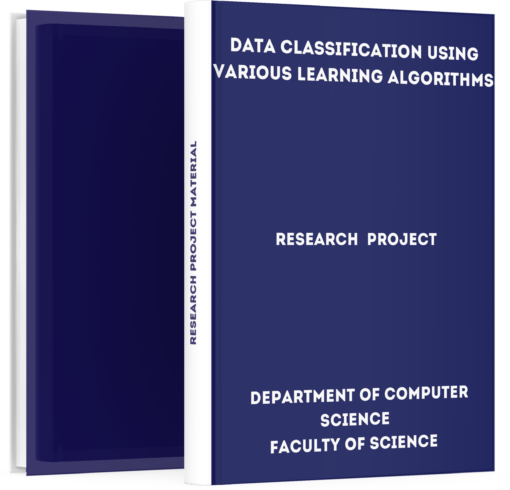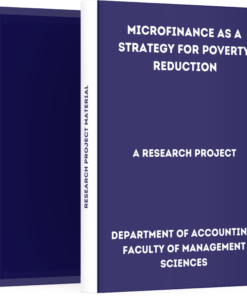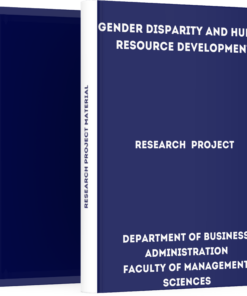Data Classification using Various Learning Algorithms
₦3,000.00
If you are interested in getting this project material “Data Classification using Various Learning Algorithms”, click on the DOWNLOAD BUTTON to make payment and the file will be delivered to your email immediately after confirmation.
Description
– Data Classification using Various Learning Algorithms –
Download Data Classification using Various Learning Algorithms. Students who are writing their projects can get this material to aid their research work.
Abstract
Dimensionality reduction provides a compact representation of an original high-dimensional data, which means the reduced data is free from any further processing and only the vital information is retained.
For this reason, it is an invaluable preprocessing step before the application of many machine learning algorithms that perform poorly on high-dimensional data. In this thesis, the perceptron classification algorithm – an eager learner – is applied to three two-class datasets (Student, Weather and Ionosphere datasets).
The k-Nearest Neighbors classification algorithm – a lazy learner – is also applied to the same two-class datasets. Each dataset is then reduced using fifteen different dimensionality reduction techniques.
The perceptron and k-nearest neighbor classification algorithms are applied to each reduced set and the performance (evaluated using confusion matrix) of the dimensionality reduction techniques is compared on preserving the classification of a dataset by the k-nearest neighbors and perceptron classification algorithms.
This investigation revealed that the dimensionality reduction techniques implemented in this thesis seem to perform much better at preserving K-Nearest Neighbor classification than they do at preserving the classification of the original datasets using the perceptron.
In general, the dimensionality reduction techniques prove to be very efficient in preserving the classification of both the lazy and eager learners used for this investigation
Introduction
1.1 Background of the Study
Data volumes and variety are increasing at an alarming rate making very tedious any attempt to glean useful information from these large data sets. Extracting or mining useful information and hidden patterns from the data is becoming more and more important but can be very challenging at the same time.
A lot of research done in domains like Biology, Astronomy, Engineering, Consumer Transactions and Agriculture, deal with extensive sets of observations daily. Traditional statistical techniques encounter some challenges in analyzing these datasets due to their large sizes.
The biggest challenge is the number of variables (dimensions) associated with each observation. However, not all dimensions are required to understand the phenomenon under investigation in high-dimensional datasets; this means that reducing the dimension of the dataset can improve accuracy and efficiency of the analysis.
In other words, it is of great help if we can map a set of points, say n, in d-dimensional space into a p-dimensional space -where p << dso that the inherent properties of that set of points, such as their inter-point distances, their labels, etc., does not suffer great distortion. This process is known as Dimensionality reduction.
A lot of methods exist for reducing the dimensionality of data. There are two categories of these methods; in the first category, each attribute in the reduced dataset is a linear combination of the attributes of the original dataset. In the second category, the set of attributes in the reduced dataset is a subset of the set of attributes in the original dataset.
How to Download this Project Material
First, note that we are one of the best and most reliable online platforms because we don’t retain any of your personal information or data as regards making payments online.
PRICE: ₦3,500 ₦3,000 (Three Thousand Naira Only)
Make a bank deposit or mobile transfer of ₦2,000 only to the account given below;
Bank Name: UBA Account Number: 1022564031 Account Name: TMLT PRO SERVICES
After making the payment, CLICK HERE to send the following on WhatsApp;
- Depositor’s Name or Screenshot of Payment
- Name of the Past Question
- Active Email Address
or Call Us On +2348082284439 Once your details have been received and your payment confirmed by us, you will receive the past question in your email or WhatsApp within 5 Minutes.
Guarantee of Getting the Material
We understand that due to the high rate of fraud, many people are afraid of making purchases online but be rest assured that PastExamQuestions will deliver your material after payment.
Once your details have been received and your payment confirmed by us, you will receive the past question in your email or WhatsApp.
Give us Feedback
Have we been able to satisfy you? How well do you think the material will be helpful after having gone through it? Does the price worth the material?
Let’s hear from you! We recommend that our customers give feedback at the end of every transaction to enable us to serve better. You can do this by clicking the review button on this page.
Where is the review button? >> Just scroll up to where you see reviews





Reviews
There are no reviews yet.